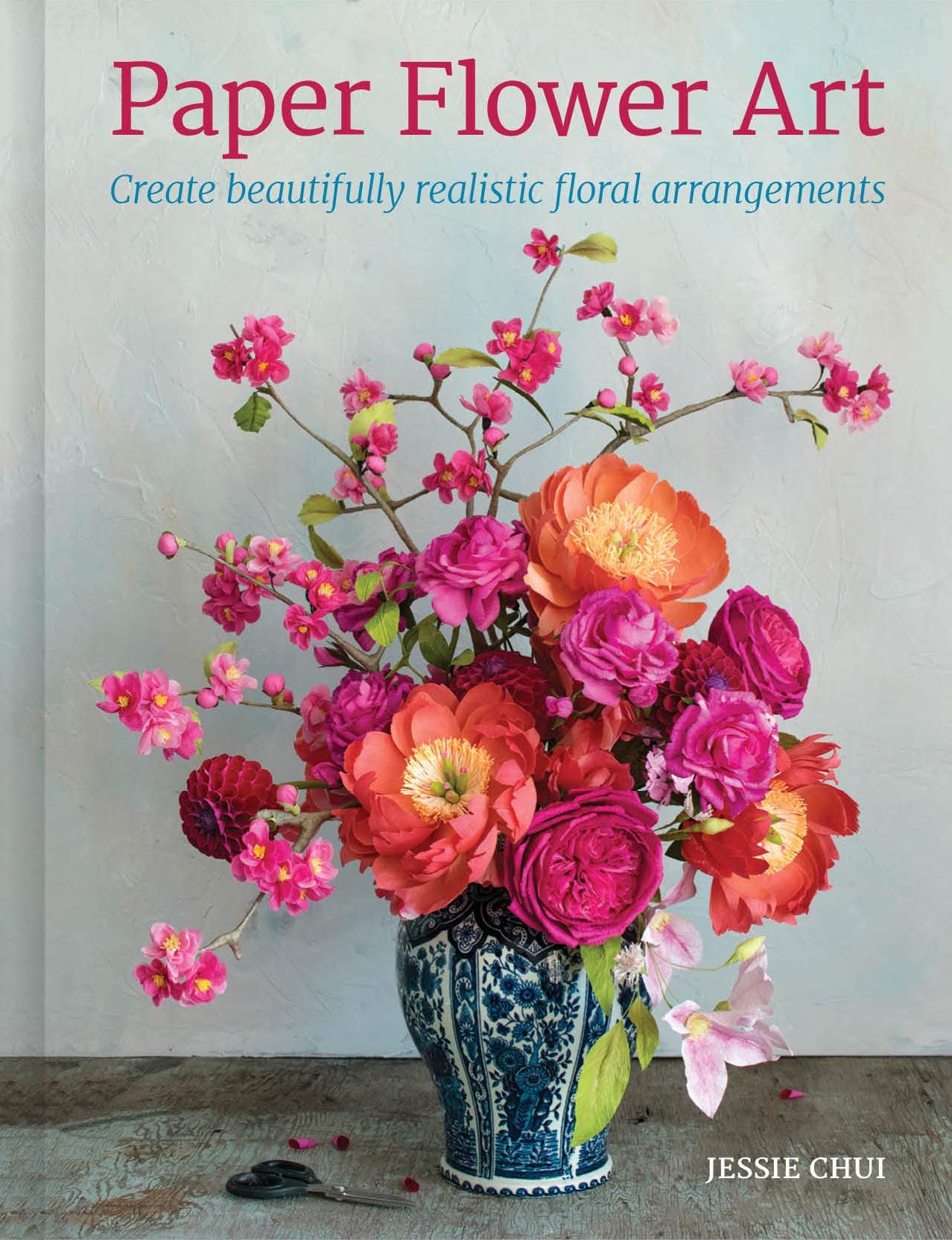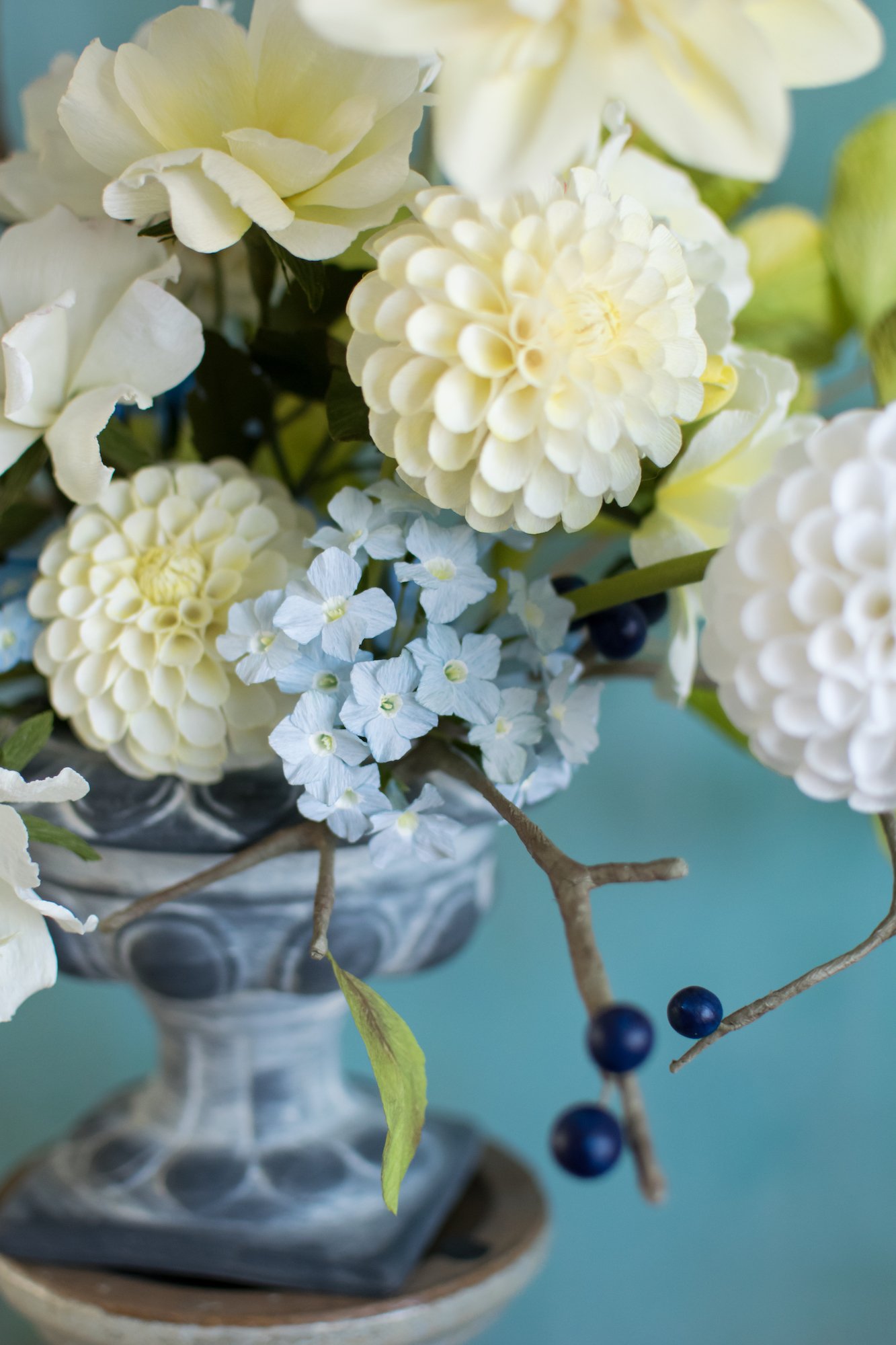Paper Flower Art Book
One of the 5 arrangements in my book with step-by-step instructions
DISCLOSURE — When you click on my affiliate links, I may earn a commission for qualifying purchases made through Amazon.com links in this post. This commission goes directly into the maintenance of my website, the technology that goes into my courses, and my art. Want to know more? Read my Amazon Affiliate Disclaimer.
I shot both a dark and light version of this cover and this is what the publishing team chose.
It's out! The book I've been working on for the last year finally has a name and a cover. It's called "Paper Flower Art: Create Beautifully Realistic Floral Arrangements" and it is being published by GMC Publications. Although it is on sale now, it will be released in November 2019 in the U.K. and in January 2020 in U.S.A. and Canada.
You can pre-order the book on Amazon.co.uk OR on Amazon.com.
It's been some time coming. When I was first approached by GMC Publications for a paper flower book commission back in June of last year, I thought the email was spam. No joke! It wasn't until I spoke with the publisher on the phone that I let myself appreciate the real possibility that I could one day be an author. I think as artists, you never think you're ready to spill all your beans because you never think you're "quite there" yet. Who am I to author an entire book devoted to my work, my techniques, my photographs?! It seemed so unreal to me. You see, every so often, I have severe doubts about the originality of my work and techniques. It's one of the reasons why I rarely talk with glowing enthusiasm about my new skills or techniques - because in my head, it's not new or unique - it just is, so what's the hype? It was something I had to come up with - a necessity - to overcome a barrier in the way the flower looked or was structured or coloured. And because it's a necessity, it's just good old problem solving and being resourceful. So you see, it's no big deal. It's not like I resolved global warming. This is how my mind works. So I have to consistently remind myself that just because I live in my own bubble and everything I do is familiar to me, no one else lives in my bubble and it can be new to them.
I've been asked if I thought it was a daunting task. Yes and no. Yes because it literally took out three months of my life where I worked on the book every day, either writing, making, shooting, or editing, and I had to miss many of my son's activities while my husband took on the majority of the cooking and cleaning chores. Yet, it was also not that daunting - I had already taught workshops for some of the flowers in the book, so I already had some text ready; I also had only 2 deadlines and I could determine what to submit on those deadlines; I was used to writing because of my years in school and practicing in litigation; and I was familiar with shooting photographs of my work and editing them. Generally, whenever I get stressed about something, I always put it into perspective based on my own personal experience as a lawyer. No one's life is on my shoulders, no one is going to lose their child, and I have no moving deadlines that I cannot control. I'm accountable only to myself and my publisher from this date to this date. Everything else - the writing, the shooting, the planning - is all under my control. I might not sleep, but that's ok. I knew I could finish it under my own terms. That gave me the confidence not to feel completely overwhelmed (until I had to work on the Masterclass stuff!).
One of the five arrangements in the book - this one is a bouquet
Blue phlox and ball dahlias
While I was finishing the book, there were two things that I was really adamant about. One of the things was acknowledging the artists whom I learned certain techniques from (the ones I could remember), so I footnoted like crazy! I couldn't help it; after years of schooling, writing theses and factums, it's one of those things that get ingrained in you. Unfortunately, my editor thought it was too distracting, so she removed every bit of it. The only thing that remains of my acknowledgements is in the said aforementioned section and the Introduction. This made me a bit sad because it was extremely important to me that these artists knew I learned from them. I don't want to take ownership of a technique that I did not come up with originally (even though at some point, that technique becomes so popular that it becomes mainstream), although I am also not afraid to lay claim on adaptations of these techniques and to give myself some credit for coming up with my own techniques that are necessary. Anyways, when I re-read the Introduction, I feel confident that I've made clear that many of my techniques are influenced by others.
The other thing that I was incredibly specific about was the colour on the printed pages. My artistic approach is very much reliant on colour and specifically, colours relative to other colours. So a pink flower may look too cool when placed next to a yellow-green leaf, but when placed next to a blue-green leaf, its colour looks perfectly balanced. If that relativity is thrown off, then the entire image - its mood, its design, the feel - will be different, like an entirely different image (one of the reasons why I don't apply filters to photos of my art). More importantly, if the colours on the page don't reflect the colour of the flower you make using the crepe paper I recommend, then it sends a strong signal to the reader that perhaps I haven't thought through my colours (even though I had, every single petal) and it would erode my authority on that subject matter. When the book was at its final stages, my RBG images were retuned to CYMK and to look better on uncoated paper. I didn't expect it to look so different. I was really upset, and I toiled over a long email, editing and re-editing so I actually sounded like a rational, clear-thinking, reasonable person. I wasn't sure what their response would be. They had already given me so many liberties and creative freedom with the flowers, arrangements, and photography. Needless to say, I was incredibly relieved when they responded to me the very next day. I really couldn't have asked for a better response - my publisher and his team made sure to send me a print copy of the final colour pages for me to comment on, provide colour samples if necessary, and for them to adjust - before it went to print. Rather than dismissing my concerns, they addressed them directly and I thank them wholeheartedly for this. As an artist and author, my biggest fear is not being heard and my art not being respected. I'm not sure what other people's experiences with their publishers are/were, but mine has been very very positive indeed.
So, I know I haven't actually talked too much about what's in the book. That's because there's an excellent summary of it (written by the marketing team) on the listing on Amazon. The summary right now isn't entirely accurate (there's no magnolia or foxglove in the book), but 90% of it is. What I've mentioned here in this post you won't read in the summary, or really anywhere. It's just my personal thoughts about the book and the process it took to get there. So thank you for reading this!




